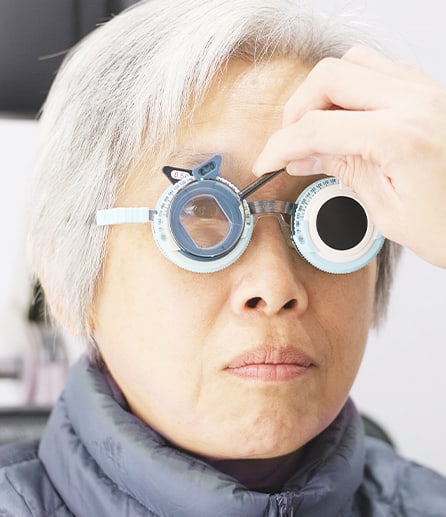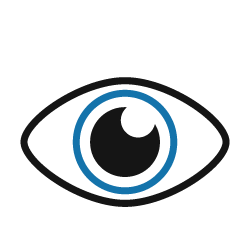Guard Your Eyes Against the Unseen
Not everyone knows how valuable routine eye exams are. Many people think that if your vision is clear and you don’t need glasses, you don’t need an eye exam—but a visit to the optometrist goes so much deeper.
The eye’s inner workings are complex, and modern technology allows us to see inside the eye to seek signs of disease. With many eye problems, early detection is the key to preserving vision and health.
An eye exam at Highstreet Eyecare Center is your first line of defence—let us protect your eye health.


How We Diagnose Eye Diseases
At Highstreet Eyecare Center, your eye health is our top priority. We use high-end tech to monitor your eyes, searching for signs of any problems before they interfere with your vision. Our tests include:
- Specialized evaluations for diabetic eye diseases to help prevent vision loss for those with diabetes
- Eye pressure testing with non-contact tonometry or Goldmann applanation tonometry
- Measuring your visual field to ensure your peripheral vision is healthy
- Optomap retinal imaging for a 200° view of your inner eye
Our skilled optometrists are trained to evaluate your eye health efficiently and effectively.

Common Eye Conditions
Build your knowledge about some of the more commonly occurring eye diseases. Even those without symptoms can be detected by a routine eye exam.
Glaucoma
Glaucoma is a group of eye conditions that lead to progressive damage of the optic nerve. It’s one of the leading causes of blindness in Canada and is sometimes called “the silent thief of sight” because it lacks early signs.
Glaucoma is often (but not always) linked to increased intraocular pressure (IOP). There are many types of glaucoma, the 2 most common being:
- Open-angle glaucoma, which is caused by poor drainage of the eye’s fluid. It occurs slowly over time and has no symptoms. 90% of Canadians who have glaucoma have this type.
- Angle-closure glaucoma, which is less common but is considered a medical emergency. It occurs when the drainage angle in the eye is blocked and results in a rapid rise in pressure. Symptoms include pain, nausea, vomiting, and headaches. If you experience these symptoms, please contact us immediately.
Glaucoma can be managed with medication or surgeries aimed at reducing eye pressure.
Cataracts
Cataracts are the clouding of the eye’s lens. They often occur during aging—almost everyone develops cataracts past 60. Symptoms can include:
- Blurred vision
- Dull or muted colours
- The sensation of looking through a film over your eyes
- Light sensitivity
- Halos or glare
Cataracts can be treated with an updated glasses prescription, and in more advanced cases, a routine and safe intraocular lens replacement surgery.
Pink Eye
Conjunctivitis, or pink eye, is inflammation of the conjunctiva, a thin membrane that covers the white of the eye (the sclera). It’s characterized by:
- Red or pink eyes
- Itching or burning sensation
- Swollen eyelids
- Watery eyes
- Goopy, watery, or stringy discharge
- Irritation or pain
There are different types of conjunctivitis:
- Infectious
- Bacterial
- Viral
- Allergic
- Chemical
Treatments for each type vary, so see your optometrist to find out how to manage pink eye and prevent any lasting damage.
Diabetic Retinopathy
Diabetic retinopathy is caused by high blood sugar and leads to weakening, swelling, and leaking of the retina’s blood vessels. It’s a common condition for diabetes patients.
Read more about diabetic eye disease and our diabetic eye exams here.
Age-Related Macular Degeneration
Age-related macular degeneration (AMD) refers to macular damage that affects central vision. It has few symptoms in the early stages but can lead to:
- Dark spots in the central vision
- Wavy or distorted lines
- Difficulty recognizing faces
There are 2 types of AMD: wet and dry.
- Dry AMD is the most common, accounting for 9 in 10 cases. The macula gets thinner, and accumulations of drusen are deposited. A vitamin regimen has been developed that seems to help slow dry AMD’s progression.
Wet AMD is less common but more serious. It’s caused when fluid leaks from abnormal blood vessels on the retina, causing scarring that leads to vision damage. Wet AMD requires treatment as soon as possible.
Protect Your Sight
There’s no need to leave your eyes at risk when all it may take to protect your sight is a visit to Highstreet Eyecare Center. Let our team play offence against eye disease. Book an appointment today.












